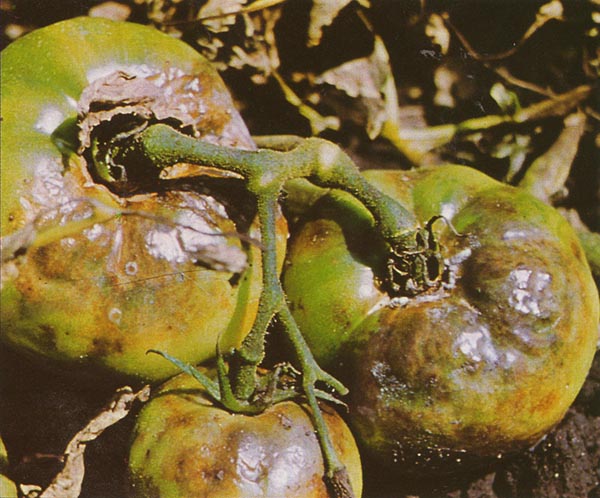Vegetable gardeners need to be on the lookout for a highly infectious plant disease known as late blight. Late blight is a very serious fungal disease that attacks potato and tomato crops. Late blight has the potential for destroying not only home gardeners’ crops, but also fields of commercially-grown potato and tomato crops.

Late blight is the disease that caused the disastrous Irish potato famine in the 1850s and also caused an epidemic in the northeastern United States in the 1840s. This devastating disease was brought under control with fungicides by the 1970s, but in the late 1980s new strains that are resistant to fungicides developed.
Once a plant has been infected with late blight it cannot be saved, so prevention is the best way to deal with late blight. Gardeners should be aware of late blight symptoms so infected plants can be removed immediately from the garden.
The spread of late blight is encouraged by wet, humid weather. The fungus produces hundreds of thousands of spores that can travel on the wind for several miles, infecting neighboring crops as it spreads. The late blight fungus also spreads readily from contact with infected plants or infected seed potatoes.
Late blight survives only on living plant tissue. It will overwinter on potato tubers that have been left in the ground. Once these potatoes sprout in the spring, those volunteer plants may then be a source of infection for the new crop. One way to help prevent a recurrence of late blight is to remove and destroy all volunteer potato and tomato plants that appear in the spring garden.
These volunteers and other infected plants should not be composted. Instead, they should be burned, buried at least two feet deep and away from the garden, or bagged and discarded as trash.
Potato or tomato plants that are infected with late blight will have black lesions on their leaves, and often cottony white spores can be seen on the edges of the lesions. The black lesions appear about three to seven days after the plant has been infected, and once the lesions become dry, the white masses of spores are no longer visible. Brown lesions that appear to be somewhat greasy may also appear on stems or on the leaves at the tips of stems. The greasy looking lesions often make their first appearance on stems at the junction where leaves meet the stems.
Potato tubers and tomato fruit will also exhibit symptoms of late blight that make them inedible. Infected potatoes will have brown or purplish lesions on their surface, and beneath the lesions the potato’s flesh will show a reddish brown, dry and granular rot up to a half inch deep. Infected potatoes tend to become mushy and rot in storage.
The fruit of infected tomato plants will develop dark brown, greasy looking lesions with a texture somewhat similar to an orange peel. The lesions can appear on both green and ripe fruit. Unlike the soggy lesions caused by blossom end rot, late blight lesions remain firm, although still causing the fruit to be inedible.
During periods of wet, humid weather and temperatures from 60 to 80 degrees Fahrenheit, when late blight is most likely to strike, gardeners should scout their crops twice a week for late blight symptoms. Plants that show symptoms should be pulled up and destroyed to avoid the spread of late blight spores.
If the weather forecast is conducive to the spread of late blight, and especially if late blight was a problem the previous year, fungicides may be sprayed on the plants as a preventative. To be effective, fungicides, whether they are chemical or organic, must be present on the foliage before any late blight spores drift in and land on the leaves. When choosing a fungicide, look for one that is labeled specifically for late blight.
Organic growers should look for a fungicide containing fixed copper as the active ingredient. Copper soap fungicides should be applied every seven to ten days to prevent late blight infection. Fungicides should be sprayed more frequently when weather conditions are favorable for the spread of late blight. Studies have shown that preventative fungicides are more effective against late blight if they are applied more frequently at the lowest dose suggested on the label. Frequent low doses of fungicide tend to provide better coverage on the plant than less frequent but higher doses of fungicide.
If late blight has been a problem in your garden in the past, it is especially important to rotate your crops to help prevent another outbreak. It is also vital to completely remove infected plant material from the garden. Late blight spores can overwinter in garden debris and return to re-infect the new crop. Crop rotation and good garden housekeeping can help prevent a recurrence of this devastating disease.
Since late blight can infect only wet foliage, it is important to provide good air circulation in the garden so the foliage quickly dries after a rainfall. Provide plenty of room between plants, and keep tomato plants up off the ground with trellises or by giving them a cage for support.
To avoid introducing late blight into your garden from infected seed potatoes, always purchase certified seed potatoes from a reputable grower, and do not plant potatoes with any blemishes. Look for varieties that are labeled as resistant to late blight. More blight-resistant varieties are being developed, but at this time Elba and Defender are the most resistant potato varieties available. Kennebec, Allegany and Sebago potatoes also show some resistance to late blight.
Resistant tomato varieties are also being developed. The first resistant variety is a cherry tomato known as Mountain Magic.
Until more tomato and potato varieties are developed that are resistant to late blight, help protect your garden from late blight by keeping the garden clean, applying fungicides as a preventative, and by carefully discarding any infected plants.
Mike McGroarty is the owner of McGroarty Enterprises and the author of several books. You can visit his website at Freeplants.com and read his blog at Mikesbackyardnursery.com.




Comment here